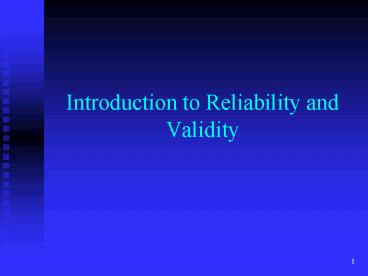Introduction to Reliability and Validity - PowerPoint PPT Presentation
1 / 14
Title:
Introduction to Reliability and Validity
Description:
Reliability is the proportion of a test's variance that is systematic ... (wrong stuff) hamper the usefulness of inferences that might be drawn from test scores ... – PowerPoint PPT presentation
Number of Views:70
Avg rating:3.0/5.0
Title: Introduction to Reliability and Validity
1
Introduction to Reliability and Validity
2
A Few Preliminary Definitions
- Test Variance represents variability on how
people perform on a test
(a)
(b)
random measurement error
test variance (all of it)
- systematic
- test variance
3
More Definitions
- Systematic Variance essence is repeatability
- can be measured again (at least immediately)
- Random Variance reflects unrepeatable influences
on test performance - cannot be measured again
- cannot correlate with anything else
- is called random measurement error
4
Reliability
- Reliability is the proportion of a tests
variance that is systematic variance - If all variance is systematic, reliability 1
- If all variance is not systematic, reliability
0 - Reliability .60 means that 60 of the variance
is systematic remaining 40 is random
measurement error - Reliability is an index of whether test scores
are reasonably free of random measurement error.
5
Another Kind of Error
- Systematic measurement error repeatable test
variance that taps the wrong stuff
(c)
random measurement error
- non-error
- test variance
systematic measurement error
6
Validity
- Both random errors of measurement (unrepeatable
stuff) and systematic errors of measurement
(wrong stuff) hamper the usefulness of inferences
that might be drawn from test scores - Both limit the validity of a test
- Validity refers to whether a test can be shown to
measure what it is supposed to measure (and not
other stuff instead)
7
Subdividing Systematic Variance
- Non-error test variance may have several
components systematic measurement error may also
have several components
(d)
random measurement error
Three components of non-error test variance
two sources of systematic measurement error
8
Dimensionality of a Test
- Can investigate the number of components of
systematic variance in a test by using factor
analysis - Number of distinguishable components underlying
systematic test variance have to do with the
dimensionality of the test - Unidimensional versus multidimensional tests
- Dimensionality of test may change for different
populations
9
Random Measurement Error
(e)
random measurement error
Three components of non-error test variance
two sources of systematic measurement error
10
Reliability Sets Maximum Correlation
- The reliability of a test sets an upper limit on
the tests correlation with any other measure
Maximum test x can correlate with another measure
Reliability of test x
11
Example
- For a test with a reliability of .80, 80 of the
variance is systematic, and therefore,
predictable - Thus, the maximum possible correlation of this
test with another variable is
.80
.89
12
Correlation of Two Tests
- The correlation of two tests is limited by both
of their reliabilities - The maximum correlation they could attain is the
product of the square roots of the respective
reliabilities - For example, for two tests with reliabilities of
.6, the estimate of their maximum possible
correlation would be
.60
.60
.60
13
Reliability of Alternate Forms of a Test
- Systematic variance would represent the same
stuff - Maximum correlation is equal to the product of
the square roots of the respective reliabilities - Two equally good tests their reliabilities are
equal - The square root of a value times the square root
of the same value equals that value so it
follows that the correlation between Form A and
Form B is the estimate of either Forms
reliability - Thus, if we want to know the reliability of
alternate forms of a test, we simply compute
their correlation
14
Reliability and correlation
- rxx reliability of test x
- rxy correlation of test x with test y































